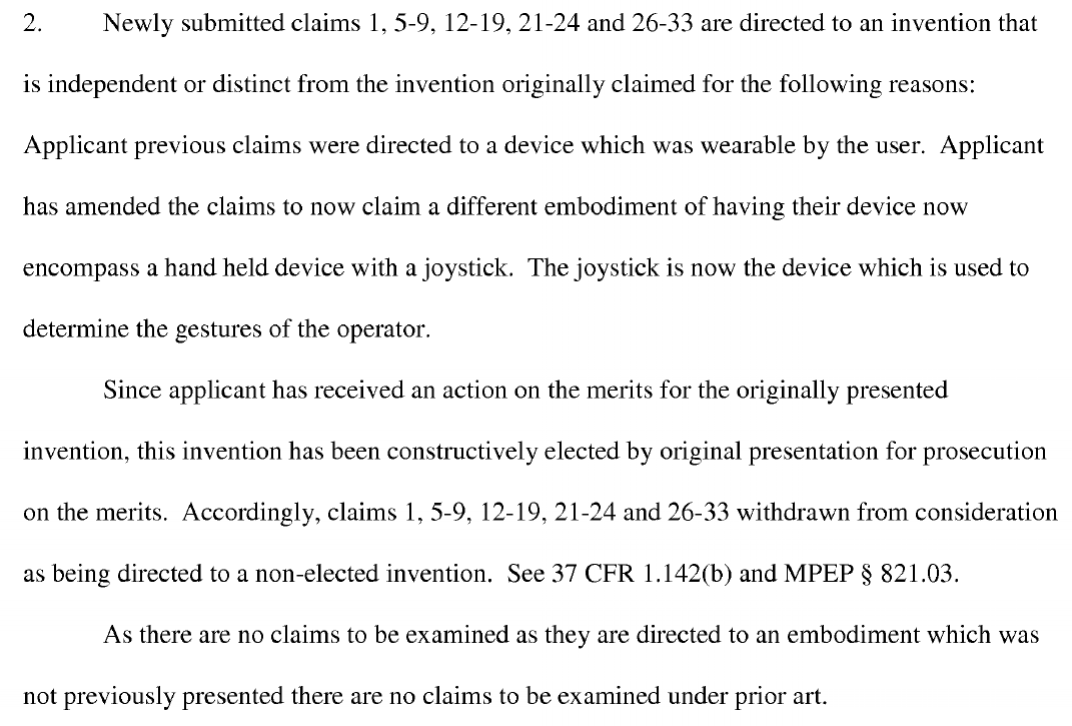This is a follow-on from a previous post.
As our readers have learned, re-opening prosecution responsive to an appeal brief is a nasty habit for some examiners and/or supervisors at the USPTO. As bigpatentdata's blog points out, only about half of all appeal briefs actually receive an Answer. A lot of that 50% includes re-opening of prosecution. As we have explained previously, it is quite unfair to the applicant (see some of the previous posts, e.g., here), as the applicant has gone through the delay and expense of preparing a notice of appeal and then full appeal brief, only to have the rug pulled out from under them and a new set of rejections thrust at them.
Usually examiners at least make the new rejection non-final. This is the least that they can do given the overall unfairness already at play. But, of course, some examiners trying to make life difficult actually re-open prosecution with a new final rejection, just to rub a little salt in the applicant's wounds. Can they do this?
Well, that is a question without a clear answer. In short, yes they can at least under some circumstances. MPEP 1207.04 sets forth the rule, but leaves much open for (mis)interpretation by the USPTO.
1207.04 Reopening of Prosecution After Appeal (emphasis added below in bold)
The examiner may, with approval from the supervisory patent examiner, reopen prosecution to enter a new ground of rejection in response to appellant’s brief. A new ground as used in this subsection includes both a new ground that would not be proper in an examiner's answer as described in MPEP § 1207.03, subsection II and a new ground that would be proper (with appropriate supervisory approval) as described in MPEP § 1207.03, subsection III. In deciding whether to reopen prosecution or to add a new ground of rejection to an examiner's answer where proper under MPEP § 1207.03 et seq., examiners and their supervisors should consider the degree to which the rejection previously of record is being changed, any previous reopenings after appeal brief, and the overall pendency of the application. The Office action containing a new ground of rejection may be made final if the new ground of rejection was (A) necessitated by amendment, or (B) based on information presented in an information disclosure statement under 37 CFR 1.97(c) where no statement under 37 CFR 1.97(e) was filed. See MPEP § 706.07(a). Ordinarily any after final amendment or affidavit or other evidence that was not entered before must be entered and considered on the merits as part of the action reopening prosecution. Where more than one after final amendments that conflict with each other were filed, e.g., the same claim is replaced by more than one amendment with new proposed claims of differing scope, than the first amendment should be entered and the subsequent amendments should not be entered.
So, a new Office action after re-opening can be final if it was based on new IDS information. That part seems clear. But, it can also be final if it was "necessitated by amendment." But the question is - what amendment? Can that be an amendment that goes back to, for example, the first Office action response? The Office's argument in allowing final rejections in such situations goes like this:
The original Final was proper (as necessitated by the amendment after the first action), and while it happened to have been a bogus rejection, that is beside the point and we are going to pretend like that first Final rejection and the appeal never happened. So, all we (the USPTO) are doing is re-issuing that Final rejection with a proper rejection, therefore it can be Final.
If that makes your head spin, you are not alone. That the applicant was forced to appeal the admittedly improper final rejection seems to be lost in this line of reasoning. Also, if correct, it essentially means that almost any time prosecution is reopened responsive to a convincing brief, the action can be final by simply "correcting" the previous Final rejection with new references. The only time it would not be applicable is if the original Final rejection was itself an improper Final! That cannot be the right interpretation of the rule as it essentially renders MPEP 1207.04 superfluous. Rather, a proper reading would be that the "amendment" referenced in the MPEP is an After-final amendment that was entered and which somehow has caused the examiner to re-evaluate the claims to realize that the previous Final rejection has been overcome. That also makes sense with the sentence in the MPEP that follows the bolded language - explaining when amendments after final must be entered when re-opening prosecution (more on this in a follow-on post).
To see how this plays out in a real example, I used the bigpatentdata.com database to identify 13/314,675. Here, responsive to a pre-appeal request, the examiner re-opened with a new final rejection. The applicant rightly complained, pointing out that no amendment was filed, nor was there any IDS filed, since the last Final rejection.
So, consider petitioning the Office if you receive an improper final rejection re-opening prosecution responsive to your convincing brief. Make sure to point out how the rule set forth in MPEP is (or is not) addressed and force the USPTO to properly justify their decision.























